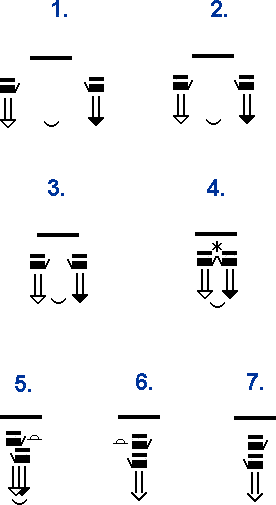
Number
1 above shows two Movement Paths that
are very wide apart from each other. Each
path is very clearly separated by a great
deal of space. There is a Right Path (black
arrowhead) and a Left Path ( white arrowhead.
Numbers
2 & 3 show the hands and Movement
Paths moving closer to each other. The
reader can tell how close by the amount
of space between the Movement Paths.
Number
4 shows the thumbs contacting each other,
but the Movement Path of the hands are
still separate, although very close to
each other.
Numbers 5 shows the hands and Movement
Paths starting to move on top of each
other.
Number 6 & 7 are the same. They use
the General Movement Arrowhead because
the Movement Paths blended together. The
left hand is on top of the right hand.
Number 6 shows the Surface Symbol stating
that the left is on top of each other,
but technically, because of the General
Arrowhead, the Surface Symbol is not needed.
Number 7 is clear that both hands move
on the same path, so the left hand would
have to be on top.





































































